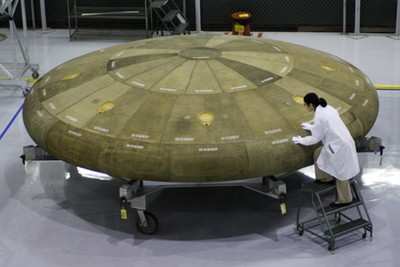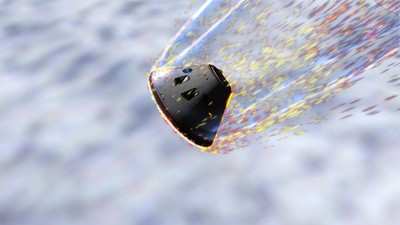Will Be Used To Test PICA Material For Reentry Duties
The building blocks for NASA's next-generation manned spacecraft
continue to come together. Boeing announced this week it has
completed a developmental heat shield for NASA's Orion Crew
Exploration Vehicle (CEV) designed to protect future astronauts
from extreme heat during re-entry into Earth's atmosphere following
lunar and low-Earth orbit missions.

NASA Ames Research Center last year awarded Boeing Advanced
Systems a contract to deliver a Thermal Protection System (TPS)
Manufacturing Demonstration Unit (MDU) for the Orion capsule as
part of NASA's Constellation program to return humans to the moon
and on to Mars.
"Boeing took on the challenge of engineering, fabricating and
assembling the largest ablative heat shield ever constructed," said
Thomas Andrews, Boeing Thermal Protection System program manager.
"Our Manufacturing Demonstration Unit met NASA's Advanced
Development Program risk reduction objectives to move the Orion
heat shield program toward full-scale development in preparation
for CEV missions."
Development of the five-meter wide TPS MDU began in late 2006 at
Boeing in Huntington Beach, CA. Last month, a NASA Ames technical
and quality inspection team successfully completed an acceptance
review of the unit. On Tuesday, Boeing shipped the TPS MDU to
NASA's Kennedy Space Center in Florida where it will undergo
additional inspection.
"The successful completion of this new heat shield is a major
achievement by our TPS team," said Alex Lopez, Boeing vice
president of Advanced Network and Space Systems. "Boeing has
greatly improved upon TPS design, analysis and production to meet
the harsh environments of lunar return missions. We have the
processes, tools and capabilities to successfully produce reliable
heat shields for Orion missions. Once again, Boeing is proud to be
supporting NASA's space exploration efforts."
Boeing's baseline TPS is fabricated from Phenolic Impregnated
Carbon Ablator (PICA) material. Fiber Materials Inc., of Biddeford,
ME produces the material under a contract to Boeing. PICA is being
considered for Orion's heat shield due to its prior performance on
NASA's Stardust spacecraft heat shield.
The Boeing TPS MDU consists of an integrated concept made up of
multiple PICA components. Each piece is significantly larger than
typical space shuttle tiles, greatly reducing parts count and
complexity.
Boeing installed the TPS MDU onto a NASA-provided surrogate
carrier structure representing the size and shape of the flight
heat shield structure, but fabricated from alternate materials
pending development of the final flight structure.

In addition to the TPS MDU, Boeing has provided NASA other
Orion-related hardware including hundreds of arc jet test coupons
(sample pieces of PICA and other materials for extreme heat
testing), structural and environmental test assemblies, and Local
Design Demonstration Units representing structural and thermal
protection components of the system that joins Orion's Crew and
Service Module elements.
Boeing is continuing its work with NASA Ames to develop the
flight heat shield design in support of Orion's TPS preliminary
design review in early 2008.
 ANN's Daily Aero-Term (04.20.24): Light Gun
ANN's Daily Aero-Term (04.20.24): Light Gun Aero-News: Quote of the Day (04.20.24)
Aero-News: Quote of the Day (04.20.24) ANN's Daily Aero-Linx (04.21.24)
ANN's Daily Aero-Linx (04.21.24) Aero-News: Quote of the Day (04.21.24)
Aero-News: Quote of the Day (04.21.24) ANN's Daily Aero-Term (04.21.24): Aircraft Conflict
ANN's Daily Aero-Term (04.21.24): Aircraft Conflict




